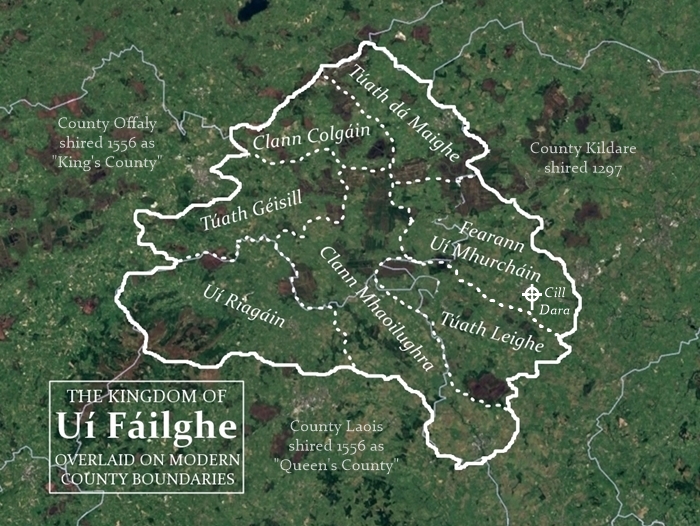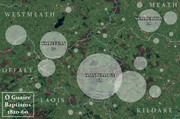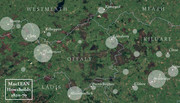Two O'Guaire appear in the Annals of the Four Masters, and these are without a doubt in the midlands, if not Offaly itself.
962. Cairbre Ua Guaire, head of the hospitality of Leinster, died.1032. Tadhg Ua Guaire, lord of Ui-Cuilinn, was slain by the son of maol-na-mBo."Head of the hospitality" infers a bishop or abbot, and "of Leinster" would seem to infer that this is the church at Kildare, as it was the head church of the kingdom of Leinster. It's vague, which is probably why it's not in the offical abbott/bishop lists. However at this time, St. Brigid's church at Cill Dara lie within the kingdom of Ui Failghe, which extended almost all the way to Newbridge, Co. Kildare prior ot the Norman invasion. This period is especially violent, as it was in the Viking Age. Kildare was being consistently looted and burned by Vikings sailing up the Liffey (much of the monastic community slaughtered). There certainly could have been a circumstance of an interloper kin-group muscling their way into an ecclesiastic office circa 960.
The Tadhg Ua Guaire in question was killed by Dermot mac Maol-na-mBo, king of the Ui Cennsalaigh and soon afterwards king of Leinster. The location of "Ui Cuillinn" is lost to history. Cuilinn is a corruption of the given name Cuilen (now Coileain), which was extremely popular in Offaly and peculiar to the O'Dempseys of Clanmaliere, who had many chiefs of the name. There are many townland names in Offaly and Laois denoting an Ui Cuilen/Ui Coileain kin group, whether there were multiple or which may have been associated with the O'Guaire is a mystery. A side-note: I think it's certainly possible "McLain" could be an odd variant of MacCoileain, however once I was able to find O'Connor Faly hiring Redshanks, I had to take my name for face value barring a match to a "Cullen" or
"Killan" etc.
Now to the name in the Fiants...
"Guaire" was pronounced "Goo-uh-reh" initially, with a rolled "R", it gave the impression "Guwoodeh". This pronunciation went on in Offaly through the 16th century, but outside of here, the "Goouhree" was dominant, which probably had something to do with the English language being more prevalent. Interestingly, the mac-prefix was dominant in the midlands. The name is quite corrupted and bastardized by the english pen, from "Garre" to "Guowde", and sometimes the G blends into the hard consonant of the "Mac". It's clear the writer is guessing as to what the last syllable or vowel really is.
28 Aug 1551 Molmore M'Iguowde, kern (possibly Geashill, but many listed are O'Dempsey kern)
28 Oct 1562 Murrough macGarre (w Lysagh m'Morrough O'Connor, who held pt of Geashill)
11 Jun 1575 James Maguodo, kern (w Cormac mac Brian O'Connor, who employed Scots)
28 Aug 1575 Donough m'Edm. M'Korroe (w Owen mac Hugh O'Dempsey of Cloneygowan)
5 Apr 1578 James M'Guoode, Cohegre M'Guoode (w M'Gillapatrick sept, who held Geashill)
4 Dec 1600 Donogh M'Gorro, of the Carrick, Co Kildare
28 May 1601 Carbry, Donnell, and Ferral M'Ewery, husbandmen, of Castleton, Co Westmeath
1 Jul 1601 Conoulough M'Guode of Philipstown (Daingean).Based on these pardons, it seems the bulk of the O'Guaire prior to 1600 were in Geashill under either the "Mac Giolla Padraig" or "Mac Laoiseach" septs of the O'Connor Faly, or in Cloneygowan area under O Diomosach. Something interesting with the first fiant in 1551: the surname seems to indicate "Mac Ui Guaire", meaning Son of the descendant of Guaire. This was something that was sometimes done to differentiate one branch of the family from another which it had split off from, perhaps in another district. Many of the individuals listed in that fiant are listed later on as kern with Owen mac Hugh O'Dempsey. Perhaps a branch of the Ui Failghe O'Guaire went to Clanmaliere? Just a theory.
In the 1659 census, there are 6 "GARRE" families in Coolestown barony, which are probably represented by the great number of Gorrys in Clonsast parish in modern times. I've attached a map I've put together of the Gorry/Gorey/Gurry baptisms 1825-65. Three large clusters develop, that is Kilbeggan, Clonbulloge, and Summerhill. One Gorry tester is from Tullamore which seems to be an offshoot of the Kilbeggan cluster, while the other is from the Summerhill group. It's my opinion that since there are no pardons in the Clonbulloge area, that all three of these groups probably diverged from Geashill-Cloneygowan in the plantation era. However it's worth mentioning that part of Clonbulloge RC parish's district comprises of half of Ballykean, so many of these baptisms are probably from there.
I'd like to find a participant from Geashill/Cloneygowan because it's a theoretical likelihood of the family's origin. Although I'm hoping to find a closer Gorry from my branch, its possible someone from here could branch off from any part of this family that has developed.
So I'll close with a pre-emptive thank you for reading, and if you have any O'Guaire relatives who you'd like to send this link to, you can either reply, or PM me. Feel free to click on the thumbnails I've added of some maps I've put together.


